8-Prenyldaidzein
8-Prenyldaidzein has cytotoxic properties against P-388 cells, its IC 50 values 5.82 ug/mL, it also exhibits very high antioxidant activity against DPPH radical scavenging.
Inquire / Order:
manager@chemfaces.com
Technical Inquiries:
service@chemfaces.com
Tel:
+86-27-84237783
Fax:
+86-27-84254680
Address:
1 Building, No. 83, CheCheng Rd., Wuhan Economic and Technological Development Zone, Wuhan, Hubei 430056, PRC
Providing storage is as stated on the product vial and the vial is kept tightly sealed, the product can be stored for up to
24 months(2-8C).
Wherever possible, you should prepare and use solutions on the same day. However, if you need to make up stock solutions in advance, we recommend that you store the solution as aliquots in tightly sealed vials at -20C. Generally, these will be useable for up to two weeks. Before use, and prior to opening the vial we recommend that you allow your product to equilibrate to room temperature for at least 1 hour.
Need more advice on solubility, usage and handling? Please email to: service@chemfaces.com
The packaging of the product may have turned upside down during transportation, resulting in the natural compounds adhering to the neck or cap of the vial. take the vial out of its packaging and gently shake to let the compounds fall to the bottom of the vial. for liquid products, centrifuge at 200-500 RPM to gather the liquid at the bottom of the vial. try to avoid loss or contamination during handling.
Arch Pharm Res.2015, 38(6):1080-9
Universidade Estadual Paulista2017, 11449
Int J Mol Sci.2020, 21(19):7209.
Environ Toxicol.2023, 38(5):1174-1184.
Curr Res Virol Sci.2022, 3:100019.
J Chromatogr Sci.2015, 53(5):824-9
Molecules.2015, 20(10):19172-88
Korean J. Food Preserv. 2021, 28(6):846-856.
Am J Chin Med.2016, 44(6):1255-1271
Chinese Pharmaceutical Journal2023, 58(2):178-187.
Related and Featured Products
Der Pharma Chemica, 2015, 7(1):206-11.
Phenolic compounds from the stem bark of Erythrina orientalis and their cytotoxic and antioxidant activities[Reference:
WebLink]
METHODS AND RESULTS:
Two prenylated pterocarpans, phaseollin (1), shinpterocarpin (2) together with flavonoids, 4'-O-methyl licoflavanone (3), alpinumisoflavone (4), 8-Prenyldaidzein (5), have been isolated from the stem bark of Erythrina orientalis. The structures of these compounds were determined based on UV, IR, HRESIMS, 1D and 2D NMR data. Compounds 1–5 were evaluated for their cytotoxic properties against P-388 cells, their IC 50 values 2.55, 2.43, 17.98, 4.31, and 5.82 μg/mL, respectively.
CONCLUSIONS:
Compounds 1, and 5 exhibited very high antioxidant activity against DPPH radical scavenging.
Phytochemistry. 2011 Jun;72(9):875-81.
Potential defense-related prenylated isoflavones in lactofen-induced soybean.[Pubmed:
21477824]
METHODS AND RESULTS:
An integrated LC-MS and NMR metabolomic study was conducted to investigate metabolites whose formation was induced by lactofen (1), a soybean (Glycine max L.) disease resistance-inducing herbicide. First, LC-MS analyses of control and lactofen (1)-induced soybean extracts were performed. The LC-MS raw data were then processed by a custom designed bioinformatics program to detect the induced metabolites so formed. Finally, structures of unknown induced metabolites were determined on the basis of their 1D and 2D NMR spectroscopic data. Structure of two previously unreported compounds, 7,8-dihydroxy-4'-methoxy-3'-prenylisoflavone (2) and 7-hydroxy-4',8-dimethoxy-3'-prenylisoflavone (3) were elucidated together with four known prenylated compounds, 3'-prenyldaidzein (4), 8-Prenyldaidzein (5), 3'-prenylgenistein (6), and 4-prenylcoumestrol (7). Compounds (2-6) are reported for the first time in soybean, as are the (13)C chemical shift assignments for compound (7). Formation of these six prenylated compounds was also induced by the primary defense glucan elicitor from the cell wall of the pathogen Phytophthora sojae (Kauf. and Gerde.), further suggesting a potential role in soybean defense.
CONCLUSIONS:
These results highlight the metabolic flexibility within soybean secondary product pathways and suggest that prenylation may be associated with defense responses. Moreover, this study demonstrates a promising future approach using metabolomics on elicitor-induced plants for discovery of unknown compounds even in relatively well studied plants.



